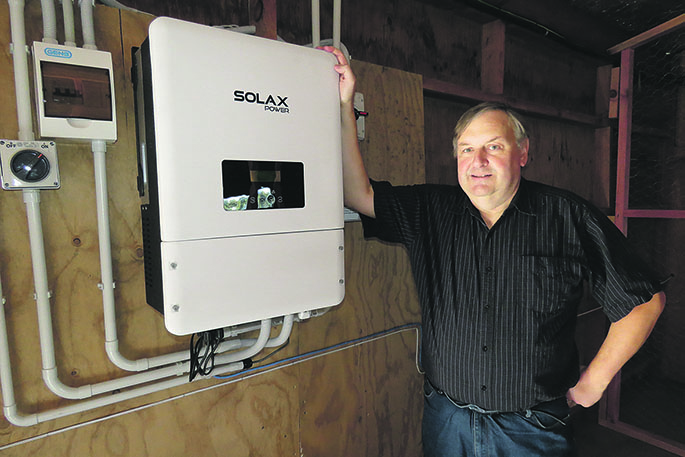Robert Thode measures every aspect of his Te Puke orchard operation with a ‘sustainability ruler’.
Now the kiwifruit grower has installed the first hybrid commercial three-phase solar power system in the country onto a 24m by 12m shed on his property.
In time he hopes to be totally self-sufficient by using his solar system as his main source of power for running his orchard – and ‘mains power’ will become his back-up.
“My aim – and what I imagine a lot of farmers in New Zealand will be doing soon – is to move to this kind of system and use it as my first source of power.
“My intention is to draw very little off the grid. That may be bad news from the power companies’ point-of-view but it is good for NZ.”
Very passionate about sustainability, Rob hopes by sharing his story fellow orchardists, farmers and other rural businesses will consider moving to solar power in the near future.
Rob purchased his 10ha in 2006. Today he has 4.3ha of orchard but is increasing this to 8ha. “I grow just over 3ha Hayward green and 1.3ha of kiwiberry.”
“Out of Psa-V one of the lessons for me is to try and be as self-sufficient as possible.”
Three-phase inverter
“Things like frost protection for a kiwifruit orchard are very important – this means you need a back-up power source.”
Dobsons Refrigeration & Electrical Ltd in Te Puke installed his solar set-up. Refrigeration sales and service engineer Stuart Walker says Rob has – after a lengthy certification process – 15kW of power generation.
“The theory behind solar energy is you start with a stage and build a battery storage system as you would with a hydro power station backed up by lake storage.
“Being three-phase commercial means it runs three-phase motors with a true three-phase inverter, which balances efficiencies. Other set-ups run three-phase gear with three single-phase installations.”
Rob says going three-phase “basically halved the cost of putting in what I needed”.
“If I was trying to do what I’m doing with single-phase solar – it would have cost twice as much and wouldn’t have been as utilisable.”
Stuart says solar panels are fixed on Rob’s shed roof to collect as much sun for most of the day as possible.
“It’s all about building your racking system at the panel configuration for maximum harvest.”
Stuart’s also installed a high-voltage battery system – about 600 volts but in DC. “With this you can bank up energy from the solar panels to use whenever.
“Plus, the equipment’s operation life is 10-plus years – if maintained it should last longer.”
Health and safety
Stuart says the “system’s brains’ monitors everything “and it goes online so you can monitor your system; if there is an issue you can check what it is wrong”.
Rob also happily went the extra mile in terms of health and safety. “We’ve situated the inverter and battery system inside a wire mesh cage in the shed.”
Rob ssays Dobson’s has done all of his electrical work for years. “For me it was a natural partnership. Being in Te Puke they have an orientation toward the farming community. They understand where we are at from the beginning, which makes an enormous difference.”
“Dobson’s immediately understood exactly what I was on about and knew exactly what I needed.”
“This is brand new,” says Stuart. “But this is where we want to go. The domestic market is there but we’re more set up for commercial applications.”
Rob believes we’re on the edge of a commercial solar power revolution in rural NZ.
“I don’t think there’s going to be a farm in five years’ time that doesn’t have significant solar. We’re already using solar panels on gates, pumps, road works signals, on a small-scale.
“A milking shed can use at least $1200-$2000 of power monthly – imagine the effect this could have on dairy.”
Greater sustainability
Rob’s orchard has multiple water pumps for
irrigation in summer and frost protection in winter.
“Usually frost hits 12am or 1am and lasts until 8am. When the temperature drops pumps turn on and pulse; we don’t use huge amount of water to beat frosts. Here in the BOP I do a light irrigation only when needed.” He has many online systems using power, which run 24/7. His harvest system, set up by Dobsons, monitors weather continuously online.
Hence, Rob says his three-phase solar system is very significant. “Every farmer in NZ could produce all of the power it needs to run different things.
“The ability for this set-up to provide greater sustainability on-farm is huge.”
But Rob says everything on-orchard needs to be justifiable economically. “There’s a lot of development happening on the sustainability front – I’m hoping the Government will make changes to the bureaucracy so we can move through it quicker.”
He says the certification process has to get easier, to encourage farmers to take up solar.
“We need performance requirements on the public sector to deliver efficiently what we need.”
For Rob solar power is just the start. “We want to tie in wind generation eventually.”



0 Comments
Leave a Comment